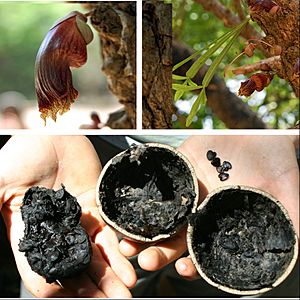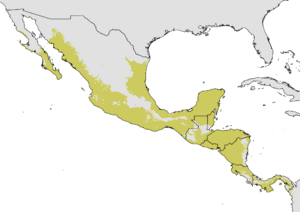Crescentia alata facts for kids
Quick facts for kids Crescentia alata |
|
|---|---|
 |
|
| Scientific classification | |
| Genus: |
Crescentia
|
| Species: |
alata
|
 |
|
Crescentia alata, also known as the Mexican calabash or jícaro, is a fascinating plant. It belongs to the Bignoniaceae family and is found naturally in southern Mexico and Central America, reaching as far south as Costa Rica. Other names for it include morro and winged calabash.
Contents
About the Mexican Calabash Tree
This plant is a small tree that can grow up to 8 meters (about 26 feet) tall. One of its most unique features is its fruit. The fruit is hard and round, looking a bit like a cannonball, and measures about 7–10 centimeters (3–4 inches) across. It's very tough to break open!
Why are the Fruits So Hard?
Scientists believe these super-hard fruits developed long ago as a way to protect the seeds inside. This was probably a defense against large, ancient animals that ate seeds, like the huge elephant-like creatures called gomphotheres. These animals lived during the Ice Age and could have easily crushed the tough fruits to get to the seeds.
However, these large animals are now extinct. This means the hard fruit strategy is a bit of a puzzle today. Most animals living where the tree grows now cannot break open the fruits. This makes it hard for the seeds to sprout, as they need the shell to be broken first.
How Seeds Spread Today
Interestingly, domestic horses can help spread the seeds. They sometimes smash the fruits with their hooves and then eat the soft inside and the seeds. This suggests that horses might be helping the plant's seeds get to new places.
A scientist named Daniel Janzen suggested that gomphotheres were once the main animals that helped spread C. alata seeds. When these giant animals died out, the tree faced a big problem. It became harder for its seeds to travel and grow in new areas. But, with the arrival of domestic horses, the plant found a new way to spread its seeds. This has helped the species continue to thrive.
You can often find C. alata trees in open areas like pastures and fields. People also grow them for their unique, gourd-like fruits.
Uses of the Fruit
The dried and hollowed-out fruits are very useful. People use them as containers for food and drinks. In Central America, local artists paint these dried fruits to create beautiful handicrafts, such as piggy banks and decorative ornaments.
Historical Importance
The fruit of the Crescentia alata tree plays a special role in the Popol Vuh. This is an ancient book of myths from the Mayan civilization.
The Popol Vuh Story
In one part of the Popol Vuh, two hero brothers, 1 Hunajpu and 7 Hunajpu, are defeated in a ball game in the underworld, Xibalba. The demon lords of Xibalba hang their skull in this very tree. Later, the skull spits into the hand of a princess named Ixquic. This magical event causes her to become pregnant. She then gives birth to a new generation of Maya Hero Twins, who go on to become great heroes.
Edible Seeds
The seeds of the Crescentia alata fruit are edible and packed with protein. They have a sweet taste, a bit like licorice. In countries like Honduras, El Salvador, and Nicaragua, these seeds are used to make a special drink called semilla de jícaro. It is a type of horchata, which is a creamy, refreshing beverage.
See also
 In Spanish: Coatecomate para niños
In Spanish: Coatecomate para niños


